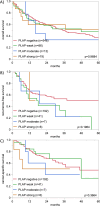PLAP expression is linked to invasive tumor growth in urothelial carcinoma of the bladder
- PMID: 39680294
- PMCID: PMC12003486
- DOI: 10.1007/s11255-024-04319-8
PLAP expression is linked to invasive tumor growth in urothelial carcinoma of the bladder
Abstract
Purpose: Placental alkaline phosphatase (PLAP) is a protein with a poorly understood function that is normally only expressed in the placenta. In cancer, PLAP expression is a hallmark of germ cell neoplasms, but it can also occur in urothelial carcinoma. To evaluate the potential clinical significance of PLAP expression in bladder cancer, METHODS: PLAP protein was analyzed by immunohistochemistry in more than 2500 urothelial bladder carcinomas in a tissue microarray format.
Results: PLAP staining was absent in normal urothelial cells but was observed in 15.9% of urothelial carcinomas, including 282 (11.5%) with weak, 57 (2.3%) with moderate, and 51 (2.1%) with strong staining. PLAP positivity occurred in 4.1% of 413 pTa G2 low-grade, 10.2% of 176 pTa G2 high-grade, and 7.2% of 97 pTa G3 tumors (p = 0.0636). As compared to pTa tumors, the PLAP positivity rate was markedly higher in 1341 pT2-4 carcinomas (19.8%, p < 0.0001). Within pT2-4 carcinomas, PLAP staining was unrelated to pT, pN, grade, L-status, V-status, overall survival, recurrence-free survival, and cancer-specific survival (p > 0.25). However, PLAP positivity was linked to p16 positivity (p = 0.0185), GATA3 positivity (p < 0.0001), and p63 expression loss (p = 0.0456).
Conclusion: In summary, these data show that PLAP is expressed in a significant fraction of pT2-4 urothelial carcinomas, unrelated to cancer aggressiveness but associated with specific molecular features. Once anti-PLAP cancer drugs become effective, urothelial carcinoma is a candidate tumor entity for clinical evaluation.
Keywords: Biomarker; Bladder Cancer; PLAP; Prognosis; Tissue Micro Array.
© 2024. The Author(s).
Conflict of interest statement
Declarations. Conflict of interest: The authors declare no competing interests. Ethical approval: The use of archived remnants of diagnostic tissues for manufacturing of TMAs and their analysis for research purposes as well as patient data analysis has been approved by local laws (HmbKHG, §12) and by the local ethics committee (Ethics commission Hamburg, WF-049/09). All work has been carried out in compliance with the Helsinki Declaration.
Figures


Similar articles
-
Cytokeratin 20 expression is linked to stage progression and to poor prognosis in advanced (pT4) urothelial carcinoma of the bladder.Exp Mol Pathol. 2023 Jun;131:104860. doi: 10.1016/j.yexmp.2023.104860. Epub 2023 Apr 14. Exp Mol Pathol. 2023. PMID: 36997051
-
GATA3 expression loss is linked to stage progression but is unrelated to prognosis in muscle-invasive urothelial carcinoma of the bladder.Hum Pathol. 2022 Dec;130:10-17. doi: 10.1016/j.humpath.2022.09.004. Epub 2022 Sep 21. Hum Pathol. 2022. PMID: 36152841
-
Pattern of placental alkaline phosphatase (PLAP) expression in human tumors: a tissue microarray study on 12,381 tumors.J Pathol Clin Res. 2021 Nov;7(6):577-589. doi: 10.1002/cjp2.237. Epub 2021 Aug 7. J Pathol Clin Res. 2021. PMID: 34363325 Free PMC article.
-
When urothelial differentiation pathways go wrong: implications for bladder cancer development and progression.Urol Oncol. 2013 Aug;31(6):802-11. doi: 10.1016/j.urolonc.2011.07.017. Epub 2011 Sep 15. Urol Oncol. 2013. PMID: 21924649 Free PMC article. Review.
-
Urachal carcinomas of the nonglandular type: salient features and considerations in pathologic diagnosis.Am J Surg Pathol. 2012 Mar;36(3):432-42. doi: 10.1097/PAS.0b013e31823fe49c. Am J Surg Pathol. 2012. PMID: 22301493 Review.
References
-
- Burger M et al (2013) Epidemiology and risk factors of urothelial bladder cancer. Eur Urol 63(2):234–241 - PubMed
-
- Knowles MA, Hurst CD (2015) Molecular biology of bladder cancer: new insights into pathogenesis and clinical diversity. Nat Rev Cancer 15(1):25–41 - PubMed
-
- Boyer SH (1961) Alkaline phosphatase in human sera and placentae: starch gel electrophoresis reveals many phosphatase components including a polymorphism in placentae. Science 134(3484):1002–1004 - PubMed
MeSH terms
Substances
LinkOut - more resources
Full Text Sources
Medical
Research Materials

